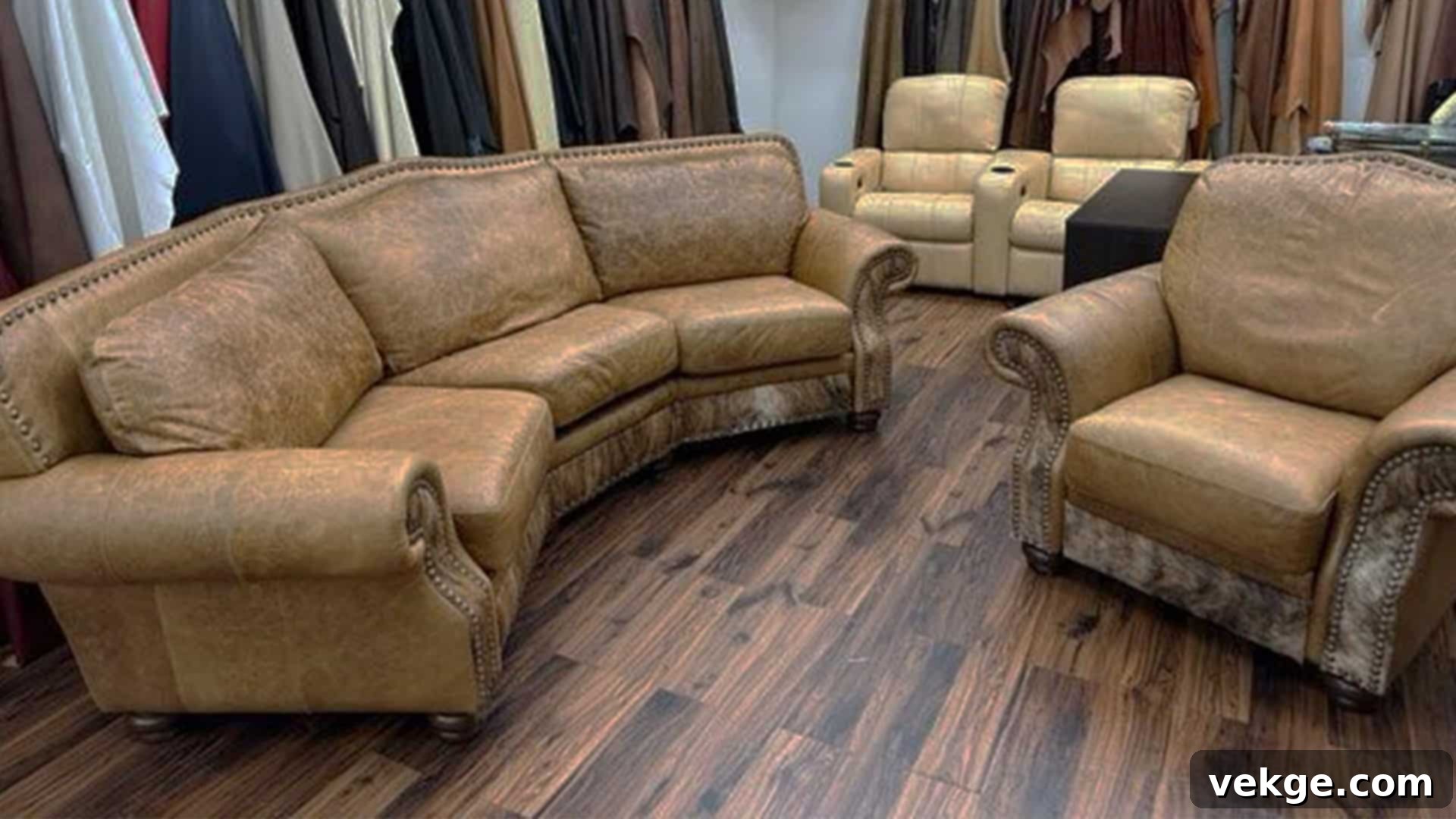How Much Does a Leather Sectional Cost? Your Complete Price Guide
A leather sectional is often viewed as a pinnacle of sophistication and comfort, transforming any living space into a luxurious retreat. These impressive pieces of furniture effortlessly blend style with practical seating, making them a highly coveted addition to many homes. However, the elegance of leather often comes with a significant price tag, which can be a major consideration for prospective buyers.
Indeed, real leather sectionals are a considerable investment. Before you commit to purchasing one, it’s essential to understand the typical price ranges and the various factors that influence their cost. This knowledge empowers you to make an informed decision that aligns with your budget and lifestyle needs, ensuring you get the best value for your money.
Are you wondering about the average cost for a farmhouse leather sectional? How much should you realistically budget? Is opting for a cheaper sectional a wise long-term choice, or a potential pitfall? If these questions are swirling in your mind as you contemplate this significant purchase, you’ve come to the right place. This comprehensive guide will walk you through the nuances of leather sectional pricing, providing valuable insights into what to expect across different price points and quality levels. Let’s delve in and uncover the true cost of these sought-after furnishings.
How Much Will My Leather Sectional Cost?

When you embark on the journey of finding the perfect leather sectional for your home, budgeting is undoubtedly one of the most critical considerations. The price tag attached to these versatile seating arrangements can fluctuate dramatically, depending on a multitude of factors and what specifically you are looking for in terms of quality, design, and features.
Generally, you can expect most authentic leather sectionals to start from approximately USD 1,000. However, this is merely an entry point for basic models. The price can quickly escalate, ranging anywhere from USD 2,000 to USD 7,000, and even soaring well above USD 10,000 for high-end, custom-made, or designer pieces. Several key determinants play a significant role in dictating where a sectional falls within this broad spectrum. These include the grade and type of leather, the quality of internal materials and frame construction, any additional upgrades or features, the overall size and configuration, and the intricacies of its design.
For instance, the specific type of leather you desire for your sofa will heavily influence the price you should anticipate. Full-grain leather, known for its exceptional durability and natural beauty, will command a premium price. In contrast, bonded leather or corrected-grain leather options will typically be more budget-friendly. If your vision for your living space includes a sectional that exudes sophisticated style, unparalleled elegance, and ultimate luxury, you will likely find your best options among the more expensive leather sectionals available from high-end retailers and luxury brands.
Average Price Range for Leather Sectionals
Understanding the general price tiers can help you narrow down your search and set realistic expectations for your budget. While prices can vary by brand, retailer, and location, most leather sectionals fall into three main categories:
1. Lower-End Price Range: USD 1,000 – USD 2,000
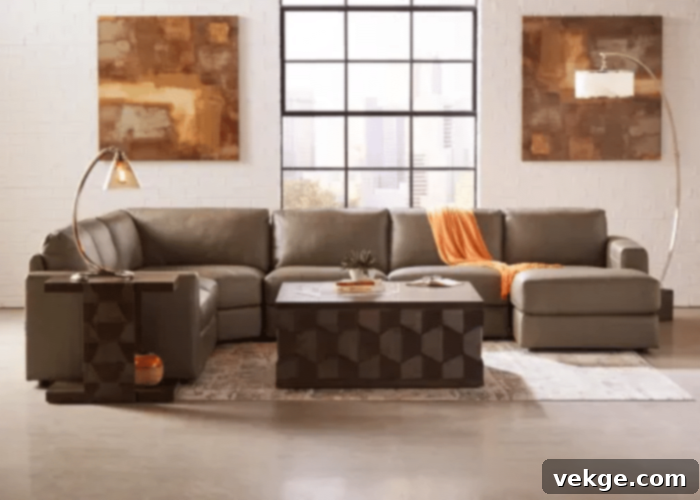
Leather sectionals in the lower-end price range typically cost between USD 1,000 and USD 2,000. This category is ideal for buyers who are working with a more restricted budget but still desire the look and feel of a leather sectional. This option aims to strike a balance between affordability and the perceived quality of the purchase. Within this price bracket, you are likely to encounter sectionals crafted with more cost-effective leather types, such as bonded leather or split-grain leather, which are less durable and may not age as gracefully as higher-grade leathers. The designs are often simpler, with fewer intricate details or embellishments.
Furthermore, the internal construction, including the frame materials (often plywood or particle board) and cushioning (basic foam), may not offer the same longevity or comfort as more expensive alternatives. While these sectionals fulfill the immediate need for seating and aesthetics, it’s crucial to manage expectations regarding their long-term durability and the extent of their luxurious appeal.
2. Mid-Range Price Range: USD 2,000 – USD 5,000
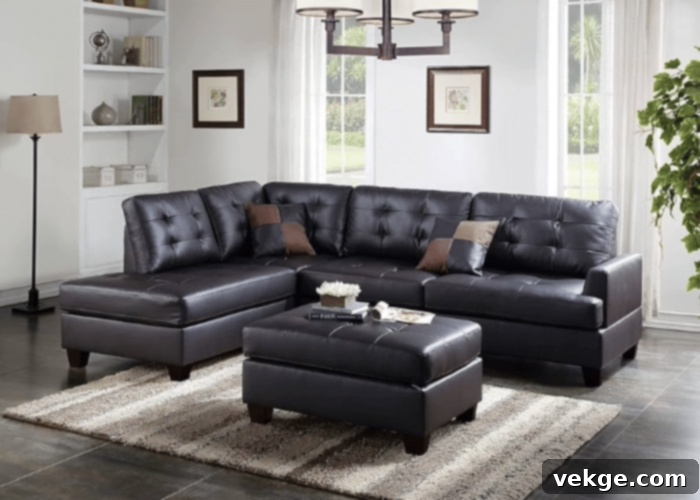
The mid-range price bracket, typically spanning from USD 2,000 to USD 5,000, is where a significant portion of customers find their ideal leather sectional. This range is popular because it offers a fantastic balance of reasonable pricing and a noticeable upgrade in both design variety and leather quality. Here, you’ll commonly find sectionals upholstered with corrected-grain or sometimes top-grain leather, providing better durability, a softer feel, and a more authentic leather experience than lower-end options.
Beyond the leather itself, mid-range sectionals often feature sturdier frames (such as engineered wood or solid wood composites), more resilient cushioning (like high-density foam with sinuous springs), and a broader array of design styles. You can expect more thoughtful details, improved craftsmanship, and enhanced comfort. This segment caters to a broad spectrum of customers who seek a durable, stylish, and comfortable leather sectional without venturing into the luxury tier.
3. High-End Price Range: USD 5,000+
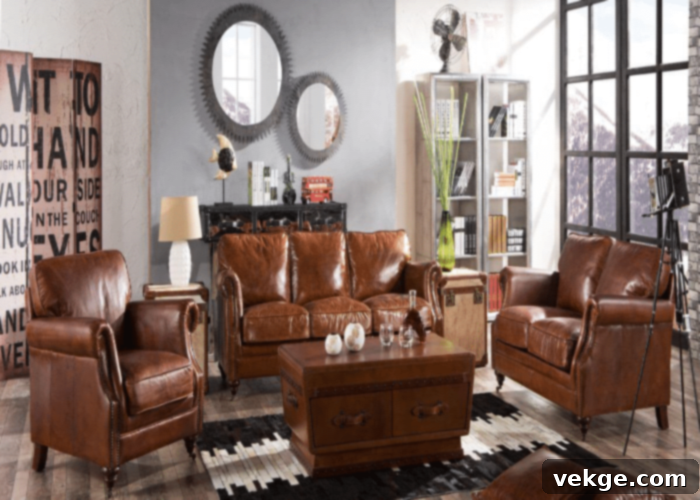
If your discerning taste leans towards designer brands, unparalleled luxury, and exquisite craftsmanship, the high-end spectrum of leather sectionals, starting from USD 5,000 and reaching well beyond USD 10,000, is your ultimate destination. This category represents the pinnacle of quality and design in upholstered furniture.
With a premium leather sectional, you are investing in top-tier materials such as full-grain or aniline leather, which boast exceptional softness, natural markings, and a beautiful patina that develops over time. Expect superior frame construction from kiln-dried hardwood, advanced cushioning systems (often involving down, feathers, or high-resiliency foam), and meticulous, often hand-finished craftsmanship. These sectionals offer unique designs, bespoke styles, and often extensive customization options, allowing you to tailor every aspect to your specific desires. The higher costs associated with these sectionals reflect not only the significant upfront investment in superior materials and labor but also often cover comprehensive warranties, premium customer service, and the prestige of owning a truly exceptional piece of furniture designed for decades of enjoyment.
It’s important to remember that there’s no single, exact price range, and costs will always vary with different stores, specific designs, manufacturing origins, and a number of other dynamic factors. To make a truly mindful and satisfying purchase decision, let’s delve deeper into what specific elements contribute to the final price tag of leather sectionals.
What Makes Leather Sectionals So Expensive?
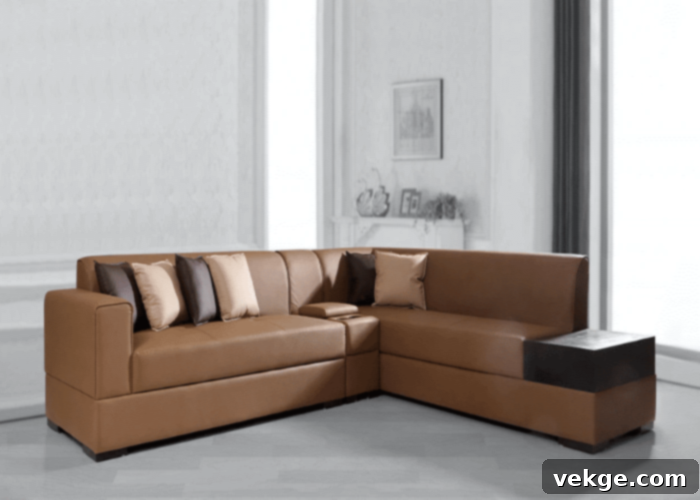
Understanding the factors that drive up the cost of leather sectionals is key to appreciating their value and making an informed investment. Several elements contribute significantly to their expense:
1. Leather Quality and Type
The first and foremost factor determining the cost of a leather sectional is the quality and type of leather used in its manufacturing. Genuine leather comes in various grades, each with distinct characteristics and price points:
- Full-Grain Leather: The highest quality, made from the top layer of the hide. It retains all natural markings, develops a rich patina over time, is incredibly durable, and offers the softest feel. It is also the most expensive.
- Top-Grain Leather: Second highest quality. The very top layer is lightly sanded to remove imperfections, then pigmented and finished. It’s durable, resistant to stains, and more uniform in appearance than full-grain, making it slightly less expensive but still a premium option.
- Corrected-Grain Leather: Heavily sanded and treated to remove imperfections, then embossed with a false grain. It’s more uniform but less natural-looking and durable than full-grain or top-grain.
- Split-Grain Leather: Made from the lower layers of the hide after the top-grain has been separated. It’s less durable, often stiff, and commonly used for suede or sometimes finished to mimic top-grain, making it a more affordable option.
- Bonded Leather: This is an engineered material made from leftover leather scraps that are shredded, mixed with a bonding agent, and pressed onto a fiber backing. While it contains some leather, its durability and feel are significantly inferior to genuine leather, and it’s the least expensive.
- Faux Leather (Vegan Leather): Entirely synthetic, made from materials like PU or PVC. It’s the cheapest option and offers no real leather properties.
If your sectional is made from premium quality, full-grain or top-grain leather, it’s inevitable that the costs will be significantly higher due to the raw material expense and the specialized tanning processes. When investing in sectionals with top-grain or full-grain leather, always ensure it has undergone proper treatment and processing to guarantee its longevity and beauty.
2. Frame Construction and Materials
The internal structure of the sectional plays a crucial role in its durability and, consequently, its price. High-quality sectionals feature frames made from kiln-dried hardwood (like maple, oak, or birch), which prevents warping and provides a sturdy foundation. Cheaper sectionals often use engineered wood, plywood, or particle board, which are less durable and prone to breaking down over time.
3. Cushioning and Support Systems
The comfort and resilience of a sectional are heavily dependent on its cushioning and spring system. Premium sectionals often use high-density, high-resiliency foam cores wrapped in down or feathers for luxurious comfort and shape retention. Durable spring systems like eight-way hand-tied coil springs or sturdy sinuous springs provide excellent support. Lower-cost options may feature less dense foam and simpler webbing support, which can sag and lose comfort more quickly.
4. Size and Configuration
Naturally, a larger sectional with more modules will require more materials and labor, leading to a higher price. Custom configurations, such as adding extra chaises, recliners, armless chairs, or built-in consoles, also increase the overall cost. The complexity of the design, including curved sections or unique module shapes, can also impact pricing.
5. Design and Craftsmanship
Intricate details, superior stitching, hand-finished elements, and unique aesthetic designs contribute to the cost. A leather sectional with elaborate embellishments, special tufting, or intricate furnishing will command a higher price due to the skill and time required for its creation. Additionally, the country of origin can impact cost; domestically manufactured, handcrafted pieces often cost more than mass-produced imports.
6. Brand Reputation and Warranty
Established brands known for quality, innovative design, and excellent customer service often price their products higher. This premium reflects their reputation, consistent quality control, and often a more robust warranty that provides peace of mind for your investment.
7. Additional Features and Technology
Modern sectionals can include a variety of integrated features such as power recline, adjustable headrests, USB charging ports, hidden storage, cup holders, and even built-in massage functions. Each of these additions enhances functionality but also significantly contributes to the overall price.
In essence, the “expensive” label on a leather sectional often reflects the sum of its high-quality parts, skilled labor, and thoughtful design, all working together to deliver a durable, comfortable, and aesthetically pleasing piece of furniture.
Why Is It Advised Not to Buy a Cheaper Leather Sectional?
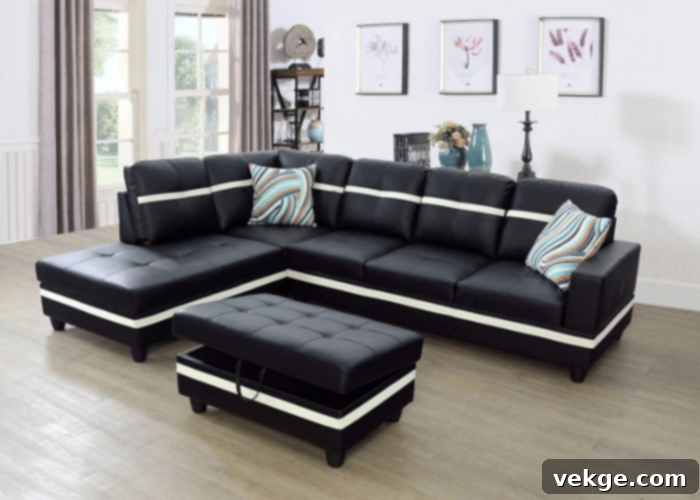
While the allure of lower upfront costs for a leather sectional can be tempting, it is generally advisable to exercise caution and often avoid purchasing the absolute cheapest options available. The primary reason for this recommendation is that, despite initial savings, a cheap leather sectional can paradoxically become more expensive in the long run. Here’s why:
- Shorter Lifespan and Premature Wear: The low cost of a cheaper leather sectional is typically achieved by using inferior materials. This often means bonded leather or thin, heavily corrected-grain leather that lacks the durability of higher grades. These materials are prone to cracking, peeling, fading, and showing wear much sooner. This shorter lifespan means you’ll likely need to replace the sectional frequently, incurring higher costs over time than if you had invested in a more durable piece initially.
- Subpar Frame Construction: Cheap sectionals often feature frames made from particle board, softwoods, or poor-quality plywood. These materials are susceptible to warping, breaking, and creaking, compromising the structural integrity of the sofa. A collapsing frame can render the entire sectional unusable, leading to an unexpected and costly replacement.
- Reduced Comfort and Support: Comfort is often sacrificed in cheaper models. They typically use low-density foam for cushioning and basic webbing for support. This results in cushions that quickly sag, flatten, and offer inadequate support, leading to discomfort and potentially affecting posture. The initial comfort often diminishes rapidly, making the sectional less enjoyable to use.
- Limited Style and Aesthetic Appeal: While some cheap sectionals may look appealing in a showroom, their designs are often basic and their leather finishes lack the depth, texture, and natural beauty of higher-quality leathers. The aesthetic appeal may not endure, and the sectional could quickly look dated or worn, failing to maintain the luxurious feel you initially sought.
- Compromised Safety: In some extreme cases, very low-quality furniture can pose safety risks due to weak construction, unstable components, or the use of hazardous chemicals in materials or finishes.
- Environmental Impact: Frequently replacing furniture due to poor quality contributes to landfill waste. Investing in a durable piece that lasts longer is a more environmentally responsible choice.
No matter if you ultimately choose a more expensive or a more budget-friendly farmhouse leather sectional, the most important thing is to make a mindful purchasing decision. This involves understanding the compromises you might be making with a cheaper option and evaluating if those compromises align with your long-term expectations for durability, comfort, and style.
Tips for Buying a Leather Sectional on Any Budget
Regardless of your budget, making a smart purchase requires some strategic planning and research. Here are some essential tips to help you find the perfect leather sectional:
1. Define Your Needs and Priorities
Before you even look at prices, consider what you truly need. How many people will it seat? Do you need a sleeper function, recliners, or storage? What is your aesthetic preference (modern, traditional, farmhouse)? Prioritize what’s most important to you – is it the highest quality leather, the largest size, or specific features? This helps you determine where you can splurge and where you can compromise.
2. Set a Realistic Budget Range
Based on your needs and the general price ranges discussed, establish a clear budget. This will help you filter out options that are either too expensive or too cheap (and potentially low quality) from the start.
3. Research Leather Types Thoroughly
As detailed earlier, leather quality vastly impacts price and durability. Understand the differences between full-grain, top-grain, corrected-grain, split-grain, and bonded leather. Decide which type offers the best balance of aesthetics, longevity, and cost for you. Don’t be fooled by “genuine leather” labels, which can often refer to lower-grade leathers.
4. Inspect Internal Construction
If possible, always ask about the frame material (kiln-dried hardwood is best), cushion composition (high-density foam, feather-down wrap), and support system (eight-way hand-tied springs or sinuous springs are good). A sturdy internal build ensures longevity and comfort, even if it means a higher upfront cost.
5. Read Reviews and Ask for Recommendations
Look for reviews from other buyers regarding specific models or brands. Pay attention to comments about durability, comfort, customer service, and how the leather holds up over time. Ask friends or family for recommendations if they’ve recently purchased a sectional.
6. Check Warranty and Return Policies
A good warranty is a sign of a manufacturer’s confidence in their product. Look for warranties that cover the frame for many years and the leather and cushioning for at least a year or two. Understand the return policy in case the sectional doesn’t meet your expectations once it’s in your home.
7. Shop Around and Compare Prices
Don’t settle for the first sectional you see. Visit multiple retailers, both online and brick-and-mortar stores. Compare prices for similar quality and features. Look out for seasonal sales, holiday promotions, and clearance events, which can offer significant savings.
8. Consider Delivery and Assembly Costs
Remember that the purchase price isn’t the only cost. Factor in delivery fees, assembly services (if needed), and any old furniture removal fees. These can add a substantial amount to your total outlay.
9. Test It Out in Person (If Possible)
While online shopping offers convenience, if you have the opportunity, visit a showroom to sit on the sectional, feel the leather, and assess its comfort and proportions. This hands-on experience can prevent buyer’s remorse.
By following these tips, you’ll be well-equipped to navigate the world of leather sectionals and make a purchase that brings comfort and style to your home for years to come, no matter your budget.
Conclusion
Making an informed and thoughtful decision when purchasing a leather sectional is of paramount importance. As we’ve explored, leather sectionals represent a significant investment, with prices typically starting around USD 1,000 and escalating to several thousands of dollars for premium, high-quality pieces.
The ultimate cost of a leather sectional is not arbitrary; it is carefully determined by a complex interplay of various factors. These crucial determinants include the specific grade and quality of the leather, the meticulous details in its design, the precision of craftsmanship, the overall design aesthetic and style, the quality of internal materials used for the frame and cushioning, the brand’s reputation and prestige in the market, and, of course, the size and configuration of the sectional itself. Each of these elements contributes to whether the final costs will fall on the higher or lower end of the spectrum.
Before you commit to buying any substantial leather furniture, undertaking detailed research is not just recommended, but absolutely necessary. This thorough investigation will empower you with the knowledge to discern true value, helping you navigate the vast market and ultimately choose the best product that perfectly fits your defined price range, aesthetic preferences, and long-term durability expectations. A well-researched purchase ensures that your leather sectional will be a cherished, comfortable, and stylish addition to your home for many years to come.
